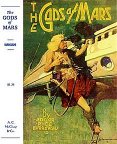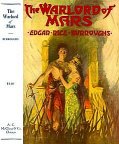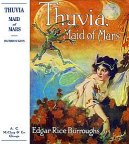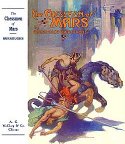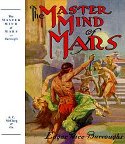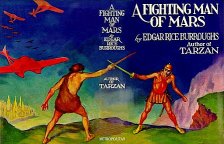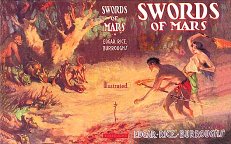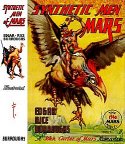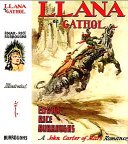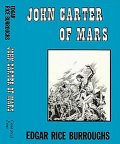"A man who escapes into fantasies of other worlds
uncovers himself with every page he creates," noted Irwin Porges in his
1975 biography of Edgar Rice Burroughs [a.k.a. ERB] (p. xiv). Sadly,
for decades few concerned themselves with Burroughs. Though more
attention has been given to the author by literary scholars in the past
twenty years, certain aspects of his work lack considered analysis.
This is true even though his books sell briskly at the dawn of the 21st
century (McWhorter, “Edgar Rice Burroughs,” [vii]; Markley, 184; Scholes
& Rabkin, 171).1
Many writing about Burroughs’ novels over the years beheld
racist fantasies on virtually every page. In 1992 Richard Slotkin
connected ERB with eugenicist Madison Grant, author of The Passing of
the Great Race (1916), and Thomas L. Stoddard, author of The Rising
Tide of Color Against White World Supremacy (1920). In John Carter,
the hero of the Martian novels, Slotkin argued the writer created his own
Frontier Myth, with Carter "as the repository of the racial energy that
will sustain, and if need be regenerate, the hegemony of the Great Race."
Another ERB critic wrote in 1994: "Racism underlies nearly all of
his writing" (Slotkin, 202; Silver). While both suggested ERB was
not racist in the modern sense, they did not realize his leap forward on
race, representing, as Robert Markley postulated in 2005, an "interplanetary
populism" that "strip[ped] Eurocentric science fiction of its imperialist
legacy."(Markley, 186-187).
A familiarity with the writings of Burroughs and with
the extensive American racist literature at the turn of the century prompts
the thesis that Burroughs' Martian novels provided an early paradigm of
racial toleration by displacing the heterogeneous race conflicts of the
United States to a remote interplanetary location, that location being
Mars. There, by the active intervention of the hero, a degree of
racial harmony is achieved. True, the lead character is white,
but this is because he was, as Richard Lupoff wrote, "Burroughs in his
most dearly imagined dreams" (Lupoff,
Barsoom, 33). In other words,
the race of the protagonist was a coincidence of the author’s birth.2
In addition, the struggle on Mars represented a conservative and peculiarly
American attempt to achieve justice within the preexisting confines of
the society. When Burroughs' heroes brought change, its purpose was
conservative -- "to restore a lost order, to put a rightful prince back
on the throne" (Orth, 223).
The Martian
Novels
 Burroughs'
Mars — "Barsoom" — was a dying planet to which Captain John Carter, a Virginia
Confederate veteran, was mysteriously transported by a type of astral projection.3
On Mars, however, he became flesh. The planet resembled somewhat
that of Percival R. Lowell about a dying civilization, though the author's
scientific understanding was sketchy at best. (Mullen, 230; Markley,
186-187; Brady, 33-34; Clute, 177-179). While the stories may show a paucity
of scientific knowledge, they revealed much about ERB's predispositions
on race. It appeared that "Burroughs develop[ed] his heroes and their
arenas for adventure according to his conception how the world is and
how it ought to be [Italics added]” (Kudlay and Leiby, 68).4
Burroughs'
Mars — "Barsoom" — was a dying planet to which Captain John Carter, a Virginia
Confederate veteran, was mysteriously transported by a type of astral projection.3
On Mars, however, he became flesh. The planet resembled somewhat
that of Percival R. Lowell about a dying civilization, though the author's
scientific understanding was sketchy at best. (Mullen, 230; Markley,
186-187; Brady, 33-34; Clute, 177-179). While the stories may show a paucity
of scientific knowledge, they revealed much about ERB's predispositions
on race. It appeared that "Burroughs develop[ed] his heroes and their
arenas for adventure according to his conception how the world is and
how it ought to be [Italics added]” (Kudlay and Leiby, 68).4
Superficially the Martian novels were action-adventure
tales for adolescent boys. Lupoff, however, in his Barsoom
found that the "tales are laden with symbols… The books have several levels
of meaning" (p. 26). Erling B. Holtsmark wrote that the author was
"in the mainstream … of his day" and had a "presumption that 'our' [i.e.,
the American] way is unquestionably desirable and therefore to be imposed."
More recently, Silver stated the society of the author "had certain racist
tendencies with which Burroughs was indoctrinated" (Holtsmark, 7; Silver).
Yet, the novels provide little substantive support for these propositions.
The above racism observations are only true in a narrow
sense. It was as Harry Stecopoulos said in a 1997: "Burroughs felt
somewhat estranged from the status quo at the beginning of his pulp writing
career." While the primary heroes in most of his novels were white
men, they had an "attraction to difference." Stecopoulos deduced that there
was racial ambivalence revealed in ERB's attitudes and writings (pp. 171,
177, 188). This attraction to difference and the accompanying ambivalence
led to flaunting of the racial norms of the era.
At the same time, Burroughs supposed "indoctrination"
was mild. In this period of extreme racism5
even the U.S. Chief Justice Edward Douglas White, a Louisiana Catholic,
was a former Klansman (Cook, 172). Though American race relations
were at their nadir, bolstered by the pervasive ideas of social Darwinism
as popularized by Herbert Spencer and William Graham Sumner, and in the
best-selling fiction of Thomas Dixon, author of The Leopard's Spots
(1902) and The Clansman (1905), as well as the pseudo-scientific
writing of R. W. Shufeldt, author of The Negro: A Menace to American
Civilization (Hofstadter, 1-66; Hayes, 330-344)6,
Burroughs' novels heralded toleration and even miscegenation.7
The above is particularly significant, for author Robyn
Wiegman argued that popular American entertainment of the last half of
the century upheld the male patriarchy through "gender sameness" of white-black
interaction whereby "the male bond displaces social fears around miscegenation"
and "[non-sexual] love of men does indeed circumvent the threat of miscegenation"
(pp. 150-155). Yet Burroughs' fiction, written over a half century
before this analysis, combined male bonding and miscegenation, exhibiting
a conception of racial interaction more developed than that in much popular
entertainment later in the century. It is revealing that Carter
married outside his race, while Tarzan mated with a civilized white woman
and therefore did not violate conventional racial norms. This may
explain not only the many Tarzan movies, but also why the Martian novels
were never made into films in the 20th century.8
A few writers, most notably biographer Porges, essayist
Jeff Berglund, and analyst F.
X. Blisard, have argued that Burroughs was not a racist. "In
fact," wrote Berglund, "his rather positive personal record of intercultural
and interracial relations might suggest otherwise." Blisard found
instances for viewing ERB as a promoter of "racial dialogue," including
the "virtual adoption of a black Civil War veteran (James
M. Johnson) into the Burroughs family," his sympathies for Native Americans,
his admiration of "Buffalo Soldiers,”" his introduction of a "black
supremacist …society in the first Barsoom sequel," and discovery of the
author’s poem "The Black
Man's Burden: A Parody" (Porges, 60, 70, 426-427; Berglund, 59; Blisard).9
Despite this, the Mars books have not been studied as the premier evidence
of the author's racial tolerance.
On the other hand, Burroughs' Tarzan novels have long
been criticized for black racial stereotyping, though Burroughs offsets
this by throwing in stereotyped malevolent whites. He actually sympathized
with the Africans. In Tarzan
the Terrible (1921), for example, there is "criticism of contemporary
attitudes toward blacks." ERB was not a subtle writer and,
had he been so disposed, his alleged racism would have revealed itself
as clearly as that of his contemporary, Thomas Dixon. (Holtsmark, 45-46,
48-49; Greer, 16-121).
Born in Chicago in 1875, Edgar Rice Burroughs spent his
youth in Illinois, Maine, and Iowa, and knew many Union veterans, including
the black James M. Johnson. He attended a military academy and served a
two-year stint in the army in 1890s, but decided against a military career.
Burroughs soon found himself married, with a family, and stifled in a clerical
job. In 1912 he launched his career as an author with the story "Under
the Moons of Mars" in the All-Story Magazine, which became the
basis of A Princess
of Mars (Holtsmark, 1-15; Brady, 353).
Given Burroughs life, it is curious that he selected an
ex-Confederate cavalry officer as the protagonist in his Mars series.
But the instant Captain Carter awakens on Mars, transported by an implausible
means from earth and is confronted by enormous green men, we see the logic
of this selection. Mars is revealed as a multiracial planet in a
perpetual state of war. Who better to recognize this racial divide
than one with direct experience of its dangers? Military dictatorship
seems the preferred form of government. Who better to deal with this
than a military man?
Of course, Carter is not just a fictional character, but
is an embodiment of the ideals of his creator. The captain's distinctiveness
and abilities derive from his earth origin and character, not his color.
No wonder Carter believed, and by extension Burroughs, "It is the character
that makes the man, not the clay which is its abode" (Swords
of Mars & Synthetic
Men of Mars, 340).
As a southern gentleman and a military man, Carter easily
adapts to the Martian environment. Among the warlike green
Martians (the Tharks), the Virginian's fighting ability endeared him (A
Princess of Mars, 1, 36). So began his encounters with the races
of Mars. In nearly every race he found an ally, the white-skinned
Therns, interestingly enough, being the significant exception. He
fought side by side with each race, and married the beautiful red Princess
of Helium, Dejah Thoris. He became a nobleman of Helium and Warlord
of Barsoom.10
The Races
of Mars
"The [science fiction] form has been a bit advanced in
its treatment of race and race relations," wrote Robert Scholes and Eric
S. Rabkin in their 1977 study of the genre (p. 187). In this arena,
Burroughs was certainly an original innovator. Unlike many authors
of the period Burroughs did not find race and gender analogous and the
frequent interracial male bonding, as noted earlier, did not preclude racial
intermarriage.11
In ERB's novels it is through the hero's interaction with a variety of
races that a truly advanced racial accommodation manifests itself.
The Tharks, a tribe of the green men of Mars,
were the first Barsoomians John Carter came into contact with when he awoke
on the Red Planet. A patriarchal nomadic people, standing fifteen
feet tall, with four arms, heavily armored, and carrying a variety of weapons,
they were both imposing and threatening. As it turns out, Carter
landed near one of their nests, where eggs were incubating. All the
races of Mars reproduced through eggs. After escaping using some
amazing acrobatics, Carter was finally confronted by one of the warriors,
who laid aside his weapons. This figure was Tars Tarkas, who becomes
Carter's first true friend on Mars. He, along with the other green
warriors, was impressed with the agility of the newcomer. The Virginian
became prisoner of the Tharks -- a status he did not long maintain (A
Princess of Mars, 29; The
Warlord of Mars, 152).
Soon after arrival at a deserted city, Carter downed a
boorish warrior and proceeded to kill one of the great white apes of Mars.
Carter noted that these events "and my feats of jumping placed me upon
a high pinnacle in [the green men's] regard…. These people fairly worship
physical prowess and bravery, and nothing is too good for the object of
their adoration as long as he maintains his position by repeated examples
of his skill, strength, and courage" (A Princess of Mars, 34).
Bret Blevins art
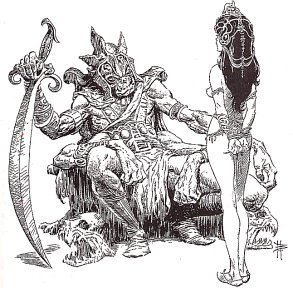 At
another point in the narrative, Carter and Princess Dejah Thoris escape
and are recaptured. Tal Hajus, the cruel Jeddak (leader) of the Tharks,
ordered the death of the Princess, adding: "But before the torture you
shall be mine for one short hour" (A Princess of Mars, 106).
This type of rape scenario is suggested many times throughout the novel,
most often with Dejah or some other beautiful red woman as the potential
victim.
At
another point in the narrative, Carter and Princess Dejah Thoris escape
and are recaptured. Tal Hajus, the cruel Jeddak (leader) of the Tharks,
ordered the death of the Princess, adding: "But before the torture you
shall be mine for one short hour" (A Princess of Mars, 106).
This type of rape scenario is suggested many times throughout the novel,
most often with Dejah or some other beautiful red woman as the potential
victim.
Carter maneuvered things in such a way as to force a battle
upon Tal Hajus, who had killed the mate of Tars Tarkas. In
a brief fight Tars Tarkas takes his revenge, kills the Jeddak, and rises
to a position of power over the Tharks. Carter now had a powerful
friend among the chieftains of Mars. He freed Dejah and returned
her to her own people (at least temporarily). Tars Tarkas later leads
the green men in alliance with Carter and Helium against the Therns, the
Black Pirates, and the yellow men of Okar (A Princess of Mars, 92-93,
156; The Warlord of Mars, 152; Wright, 41).
A number of authors have identified the Tharks with American
Indians, but Burroughs equated the red men with Native Americans.
When his hero saw a large group of them arrayed in feathers and finery,
he noted: "I could not but be struck with the startling resemblance
the concourse bore to a band of the red Indians of my own Earth" (A
Princess of Mars, 136). For the Tharks, Lupoff, in his study
of Barsoom, found another earthly parallel:
Certainly the nomadic existence
of the green men, their disdain for manual work, the role played by their
women (at once treasured and protected, yet oppressed and exploited), their
admiration of the martial attainments, their preference for desert rather
than urban life, the emphasis placed upon horsemanship (thoatmanship)—all
are suggestive of the Arabs, especially as they were known through the
popular media of Burroughs' time (pp. 50-51).
This view is more logical than seeing the Tharks as Indian-like.
Edward W. Said wrote in his book Orientalism: "If the Arab occupies
space enough for attention [in western writing], it is as a negative value"
(Said, 286). Given the average American’s association of modern Arabs with
Jihad and terrorism, if anything, the identification of the violence-prone
Tharks with Arabs may be even stronger for current readers than for readers
of Burroughs' generation.12
To say that the green men resembled Arabs does not make them such. For
one thing, they were clearly not humanoid.
In spite of the non-terrestrial language and culture of
the green men, Carter adapted to their ways with intelligence, skill, and
a surprising level of tolerance. This adaptation presaged how the
hero would later deal with the other alien races. These future interactions
were greatly simplified by the fact that all Barsoomians spoke the same
language (Roy, 125-126).
The red men of Mars were among the most
technically adept races, traveling and fighting using great air ships,
and living in the most advanced walled cities, the most important of which
were the twin cities of Helium. In physical appearance they resembled
Native Americans.
Even though Burroughs may have been slightly influenced
by the "Noble Savage" idea, it is worth considering that he was posted
in the American Southwest while in the army and had first hand familiarity
with American Indians. In fact, he produced a book in 1927,
The
War Chief, from which the editor insisted on deleting many of the
favorable comments about the Apache. The author's comparisons of
Indians with "civilized" whites were often unfavorable to whites.
His personal acquaintance with Indians in Idaho, New Mexico, and Arizona
seems to have been his inspiration for the red men of Barsoom (Porges,
426-427).13 Nevertheless,
as is proven by the ease with which ERB created villains of a variety of
racial backgrounds, including not only whites, but reds and blacks as well,
his creations avoid what Roger Sandall called, an "imaginary landscape
of romantic primitivism."14
His aliens consisted of individuals, who were both savage and noble, good
and bad. Carter even fought power-hungry red men such as Prince Sab Than
of Zodanga, a city state that challenged Helium for preeminence on Mars.
Sab Than kidnapped Dejah Thoris and threatened the destruction of Helium
unless she married him. Carter subdued Zodanga and rescued the Princess
with the help of hordes of green allies (A Princess of Mars, 138-152,
160-164).
Soon after Carter arrived on Mars, the Tharks did battle
with a fleet of air ships and captured a young red noble woman. The
Captain is immediately entranced by her beauty and falls for the scantily
clad woman, Dejah Thoris, Princess of Helium. Though Dejah is supposedly
a scientist, this idea is never developed, and she is constantly getting
herself into sexually threatening situations that require rescue by the
star struck hero (A Princess of Mars, 46, 54-59; Brady, 88).
Clearly, ERB's views on gender lacked the progressiveness of his attitudes
on race.
Few race sins at the turn of the century were more
egregious than that of miscegenation. Madison Grant warned that ignoring
race distinctions was sweeping America toward "a racial abyss," while Lothrop
Stoddard felt the need for Americans to "exorcise the lurking spectre of
miscegenation" (Grant, 228; Stoddard, 309). Dixon in
The
Leopard's Spots even asserted that to "become mulatto… that is death"
(p. 242). Despite prevailing views, it was clear early on that Carter
did not shrink from the implications of his feelings for the oviparous
Dejah Thoris, whom he believed to be "all that was perfect; all that was
virtuous and beautiful and noble and good." By the end of the novel
he and his princess are married and await the hatching of "a snow white
egg"—their first child (A Princess of Mars, 78, 171). That
the red race itself is a product of race mixing further demonstrated Burroughs'
departure from the norms of his time.15
Social Darwinists maintained the inferiority of Native
Americans as well as blacks. In Franklin Giddings' Principles
of Sociology, first published in 1896, the author declared that American
Indians were virtually exterminated because "the Indian has shown less
ability than the Negro to adapt himself to new conditions." Lord
James Bryce observed in 1912, "One seldom hears of a pure Indian accomplishing
anything or rising either through war or politics, or in any profession,
above the level of his class." Writing in 1914 geographer Ellsworth Huntington
theorized, "The Indians are very backward. They are dull in mind
and slow to adopt new ideas" (Giddings, 328-329, quoted in Degler, 17;
Bryce, 184; Huntington, 192).
In any event, in racist theory the mixture of blood of
a superior with an inferior race resulted in a lesser breed. "The
intermarriage of people of one colour with people of another colour always
leads to deterioration," wrote Alfred P. Schultz in 1908. Noting
race mixing in South America in 1915, famed Sociologist Edward A. Ross
attributed to a Bolivian sociologist the belief that a half-breed was "inferior
to both the parent races." "The valuable specializations of both
breeds cancel out," wrote Stoddard, "and the mixed offspring tend strongly
to revert to generalized mediocrity" (Schultz, 7; Ross, South of Panama,
41; Stoddard, 301).
This is especially notable because the offspring of the
union of Carter and Dejah Thoris, the young Carthoris, was a fine human
specimen. At his first encounter, having been transported back to
earth and returning to Mars after an extended period, Carter did not recognize
his own son. "His features were very regular," observed the perplexed
earthman, "and, like the proportions of his graceful limbs and body, beautiful
in the extreme." He later was much impressed with the martial prowess of
the boy (The Gods of
Mars, 93, 105). In the end, we find that Carthoris possessed
the better physical attributes of his mother and father, combined with
a sharp intelligence. He lacked any characteristics associated in
the eyes of early 20th century racists with the hated "mongrel."
In a later novel of the series, the couple had another child, a daughter,
Tara, who was also an exquisite human specimen (The
Chessmen of Mars, 7-70).
In fact, what happened in the Burroughs novel is precisely
what was being encouraged at the time by Franz Boas of Columbia University.
Boas argued against popular notions of inherent biological racial inferiority,
positing culture and environment as more important factors in explaining
race differences. As early as 1911, Boas advocated racial intermarriage
as a solution to the nation's race problem, and felt racial amalgamation
would "be of advantage" and presented "the greatest hope for the immediate
future" (Stocking, 213; Boas, “The Problem of the American Negro,” 393-395;
Degler, 79).16 Carter practiced
what Boaz preached!
The Therns were the primary white race of Mars
and held a significant position in Martian worship of the Goddess Issus.
Higher status members of the race, the Holy Therns, served as the supreme
protectors of the superstitions that constituted the primary system of
Martian belief. The Therns dwelled in the fortified palaces on the
outer slopes of the Ortz Mountains.
All Martians lived to be very old, at least one thousand
years, and seldom died of natural causes. In old age, the typical
Martian who managed to live so long would sail down the River Iss to a
supposed celestial paradise, not realizing that what awaited was either
death by the blood-sucking plant men or capture and enslavement by the
white Martians. Instead of finding Heaven, unsuspecting pilgrims
found a Martian hell (The Gods of Mars, 29; Roy, 126-129).
Carter, after sailing up the Iss, first encountered a
Thern in the Valley of Dor, land of the dead, overseeing a group of red
prisoners. The Captain saw that he was "a wicked-faced man, neither
red as are the red men of Mars, nor green as are the green men, but white,
like myself, with a great mass of flowing yellow hair…. He was about
my own height and well muscled and in every outward detail moulded as precisely
as are Earth men" (The Gods of Mars, 32-33). He later found
that the hair was merely a wig covering a bald pate.
While the Therns most resemble Carter himself and should,
based on the racialist ideas of the time, be his most suitable allies;
they proved to be the opposite. Their mercilessness, religious rigidity,
and insufferable sense of superiority made them among Carter’s most persistent
antagonists. They had few redeeming characteristics. The prisoner,
Thuvia, even told Carter in disgust, "The Holy Therns eat human flesh,
but only that which has died beneath the sucking lips of the plant man—flesh
from which the defiling blood of life has been drawn." Phaidor, the
daughter of the Thern leader, boasted, "As man may eat of the flesh of
beasts, so may gods eat of the flesh of man. The Holy Therns are the gods
of Barsoom" (The Gods of Mars, 39, 75).
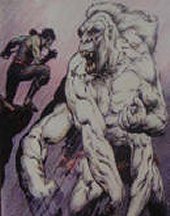 Carter’s
black ally, Xodar, explained the origins of the white race of Mars: "The
Therns are but the result of ages of evolution from the pure white ape
of antiquity. They are a lower order still. There is but one
race of true and immortal humans on Barsoom. It is the race of black
men" (The Gods of Mars, 69). It cannot be mere happenstance
that Burroughs reversed one of the most popular of racist Darwinian arguments.
This argument is best exhibited in the words of R. W. Shufeldt, who, writing
in 1907, stated that the Negro "exhibits a much closer approach to the
anthropoid apes than any other race of the genus Homo." (p. 36).
Carter’s
black ally, Xodar, explained the origins of the white race of Mars: "The
Therns are but the result of ages of evolution from the pure white ape
of antiquity. They are a lower order still. There is but one
race of true and immortal humans on Barsoom. It is the race of black
men" (The Gods of Mars, 69). It cannot be mere happenstance
that Burroughs reversed one of the most popular of racist Darwinian arguments.
This argument is best exhibited in the words of R. W. Shufeldt, who, writing
in 1907, stated that the Negro "exhibits a much closer approach to the
anthropoid apes than any other race of the genus Homo." (p. 36).
Carter felt no sense of identification with people in
whom "ages of narrow fanaticism and self-worship had eradicated all the
broader humanitarian instincts that the race might once have possessed"
(The Gods of Mars, 86-87, 182). A combined assault upon the
Therns quickly reduced their temples to rubble. The attackers "had cleared
the fortresses and the temples of the Therns when they had refused to surrender
and accept the new order of things that had swept their false religion
from long-suffering Mars," reported Carter in The Warlord of Mars(p.
5). One is struck by this twist on the Darwinian concept of "survival of
the fittest." After the fight, the small remnant of remaining Therns accepted
their defeat and "so … it was now no longer uncommon to see them mingling
with the multitudes of red men" (Thuvia, Maid of Mars, 96).
Interestingly, three other white races appeared in other
books of the Barsoom series and all were in decline. In Thuvia, Maid
of Mars the Lotharians proved able to kill "by the power of suggestion,"
but had lost "the martial spirit" and became "a race of spineless cowards."
There were no women among the surviving Lotharians and Tario, the Jeddak
of Lothar, unsuccessfully attempted to keep Thuvia of Ptarth as a captive
wife (pp. 50, 66).17 As
if to make the point clearer, a third degenerate white race, the blue-haired
Tarids, appeared in the eighth book in the Barsoom series, Swords of
Mars. This race lived upon the Martian moon Phobos. Though
they had mental powers sufficient to render themselves invisible, only
a few thousand survived. (Swords of Mars and Synthetic Men of
Mars, 124-133).18 Finally,
a fourth white race was discovered in Llana
of Gathol. The remaining members of the Orovar race, from
which Therns, the Lotharians, and even the red men descended, occupied
the ancient city of Horz. Carter stumbled across the hidden city and was
sentenced to death, but escaped. This race like the rest was sliding
toward extinction (Llana of Gathol and John
Carter of Mars, 7, 13, 22-51).19
That Burroughs pictured all of his white races in decline
and verging on extinction cannot be coincidence. To the social Darwinist
of his era extinction was the appropriate outcome for a race lacking the
ability to adapt. In Darwinian terms, dying races deserved their
fate.
The Pirates of Barsoom, a race of black supremacists,
were yet another tribe encountered by Carter in the second Martian novel,
The
Gods of Mars. They called themselves the "First Born" and were
portrayed as superior fighters, often raiding the Therns and carrying off
female captives. The women so captured were to serve as slaves
to the figure that sits at the apex of Martian religion, the Goddess Issus,
a black Barsoomian. The muted rape mythos existed in Victorian form
throughout ERB’s books, but like Martian slavery was interracial.20
John Coleman Burroughs Art
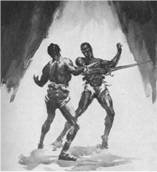 When
Carter had his first encounter with the blacks, they were attacking the
Therns and Carter was disguised as a Holy Thern in order to rescue his
beloved Dejah Thoris. Impressed by his military skills one black
cried out to him, "But for your detestable yellow hair and your white skin
you would be an honour to the First Born of Barsoom" (The Gods of Mars,
59).
When
Carter had his first encounter with the blacks, they were attacking the
Therns and Carter was disguised as a Holy Thern in order to rescue his
beloved Dejah Thoris. Impressed by his military skills one black
cried out to him, "But for your detestable yellow hair and your white skin
you would be an honour to the First Born of Barsoom" (The Gods of Mars,
59).
Burroughs went to great lengths to fully describe the
black race of Mars:
They were large men, possibly
six feet and over in height. Their features were clear cut and handsome
in the extreme; their eyes were well set and large, though a slight narrowness
lent them a crafty appearance; the iris, as well as I could determine by
moonlight, was of extreme blackness, while the eyeball itself was quite
white and clear. The physical structure of their bodies seemed identical
with those of the therns, the red men, and my own. Only in the colour of
their skin did they differ materially from us; that is of the appearance
of polished ebony, and odd as it may seem for a Southerner to say it, adds
to rather than detracts from their marvelous beauty (p. 55).
Compare the above description with the following description
written near the same time of a black Union soldier in Thomas Dixon's best
seller
The Clansman, which had already toured the nation as a successful
play in 1905-06, and was being made into a film (Cook, 135-154, 161-167)
while ERB was writing his Martian novel:
He had the short, heavy-set
neck of the lower order of animals. His skin was coal black, his lips so
thick they curled both ways up and down with crooked blood-marks across
them. His nose was flat, and its enormous nostrils seemed in perpetual
dilation. The sinister bead eyes, with brown splotches in their whites,
were set wide apart and gleamed ape-like under his scant brows. His
enormous cheekbones and jaws seemed to protrude beyond the ears and almost
hide them (p. 216).
This is a dramatic contrast for two men of basically the
same generation. Dixon, born in 1864, considered many of the blacks
he described in his novels as sub-human, whereas Burroughs, born in 1875,
rated his Martian blacks as superior human types.
That Carter’s attitude toward the blacks was indicative
of Burroughs' own real life attitude is without doubt. While in the
army, ERB worked under a black sergeant and observed: "Without exception
they [African American sergeants] were excellent men who took no advantage
of their authority over us and on the whole were better to work under than
our own white sergeants." In 1899 he mocked Rudyard Kipling’s poem
"The White Man’s Burden," with a parody that identified white culture with
bringing "the white man’s God, and rum." Then he proceeded:
"Take it because you must; Burden of making money; Burden of greed and
lust" (ERB’s Autobiography [unpublished ms.] and from parody in ERB's Scrapbook,
in Porges, 60, 72).
Notwithstanding the overall positive view presented of
the black race on Mars, one member of said race was the epitome of evil:
Issus, Goddess of Death and Life Eternal. Issus was central to the
Martian religion, upheld by both the Holy Therns and the Black Pirates
of Barsoom. Carter learned of her true nature when told by a black
friend, Xodar, that "she eats only the flesh of the best bred Holy Therns
and the red Barsoomians." Slaves were summarily executed after a
Martian year in her service. Also, Issus was supposedly beautiful,
but in fact used her telepathic powers to entrance others.
Carter, not subject to her powers, related that the true vision of the
goddess was that of an old, wrinkled hag, who was repulsive and emaciated,
except for a grotesquely "distorted abdomen" (The Gods of Mars,
87-88).
Carter, with the aid of his green and red allies and his
black friend, Xodar at his side, overthrew the hag whose merciless and
superstitious cult enslaved all Barsoom. He threw the false goddess
to the "betrayed and vengeful" First Born, who ripped her to shreds.
Thereafter, Xodar was elevated to Jeddak of the black race of Barsoom (The
Gods of Mars, 203; The Warlord of Mars, 2). Thus Carter
cemented another alliance.
The yellow men of Barsoom lived in isolation
in the frigid cold of the north polar ice cap. Carter and a friend,
Thuvan Dihn, set out on a mission toward the north to find Tardos Mors
and Mors Kajak, the grandfather and father of Dejah Thoris. In the
wastes of the north, Carter and Thuvan Dihn, come to the defense of a yellow
warrior battling five others by himself, all "fierce, black-bearded fellows,
with skins the color of ripe lemon" (The Warlord of Mars, 80).
The earthman and his friend earn the gratitude of Talu, Prince of Marentina,
who helps them gain entrance into the city of Kadabra, capital of Okar,
the land of the yellow men.
The city, encased in a giant glass-like dome, had its
own atmosphere plant. Therein Carter found that Dejah Thoris, whom
he thought safe, had fallen into the hands of Salensus Oll, Jeddak of Okar,
who had plans to marry her, proclaiming her beloved husband dead. Carter,
disguised as a yellow man, was exposed, arrested, and imprisoned.
He finds Tardos Mors, Mors Kajak, and leads a prisoner revolt that ends
in the death of Salensus Oll and the installation of Talu as the new Jeddak
of Okar (The Warlord of Mars, 97-132, 148). Thus Carter redeemed
the yellow men.
What of turn-of-the-century views on the world's yellow
races? In 1907 Shufeldt believed that while the Chinese were superior
to the Negro "they, too, from the very nature of their unprogressiveness,
are unsuited to the form of Indo-European civilization." As early
as 1901, Stanford Sociologist Ross coined the term "race suicide" to describe
Asian profundity that threatened displacement of whites. Stoddard
speculated: "There is no immediate danger of the world being swamped by
black blood. But there is a very imminent danger that the white stocks
may be swamped by Asiatic blood" (Shufeldt, 161; Johnson quoted in Matthews,
623-624; Ross, “The Causes of Race Superiority,” 87-88; Stoddard, 301).
The menace being noted was popularly termed "the Yellow
Peril." The San Francisco Chronicle called in 1905 for restrictions
on Japanese immigration along the lines of the Chinese Exclusion Act of
1882. "The yellow terror is threatening us," wrote Schultz
in 1908, "and will probably soon be at our throats." During the 1912
presidential campaign Woodrow Wilson even said of Chinese and Japanese
immigration: "I stand for the national policy of exclusion… We cannot
make a homogeneous population of a people who do not blend with the Caucasian
race" ("The Yellow Peril…;" Schultz, 178; Gyory, 1-2; Wilson, 24:238).21
At the time Burroughs was writing, the idea of the devious
oriental villain had been established as far back as 1892. While
ERB was in 1913 serializing the installments of his Warlord of Mars,
the book in which the yellow race appeared, another author, Sax Rohmer
(Arthur S. Ward) published in England The Mystery of Fu Manchu,
appearing under the American title The Insidious Fu Manchu.
Fu Manchu was "the Yellow Peril archetype" (Nevins). Burroughs, though
familiar with this popular view, did not share such prejudice.
Given the popular attitudes toward Mongoloid peoples in
the United States, it is notable that Carter found a trustworthy ally among
yellow persons. Burroughs himself once petitioned unsuccessfully
for a position as a trainer for the Chinese Army after the thwarted 1900
Boxer Rebellion (Porges, 96-97).22
This was at a time when the U.S. had excluded Chinese and was considering
Japanese exclusion, and suggests a certain liberality in ERB's attitudes.
After World War II, Burroughs did produced some
anti-Japanese polemics, calling Imperial troops "sub-men," "monkey men,"
and "yellow beasts" in his novel Tarzan
and "The Foreign Legion" (1946). This seems to have been
prompted more by his familiarity as a war correspondent with wartime atrocities
than by inherent racism (Greer, 27-29). If anything, this makes
his earlier toleration of yellow people an even more outstanding demonstration.
Conclusions
The popular racial attitudes in the America at the beginning
of the 20th century centered around the concept of Anglo-Saxon superiority.
The idea of equal political rights for minorities had lost much of its
appeal, especially after the U.S. obtained foreign possessions occupied
by non-white peoples (Bloomfield, 400-401). Other races were thereafter
definitely viewed as inferior, with gradations from Asian to African—the
latter at the bottom in the Darwinist schemata.
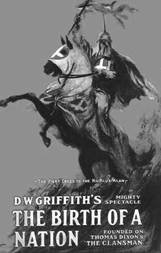 The
success of Thomas Dixon proves the point. Dixon's novels sold millions
and were reviewed in the New York Times and other journals at a time when
Burroughs' books were seldom noted.23
The silent film, Birth of a Nation (1915), based primarily on the
author's Reconstruction novels, made Dixon a millionaire. The
Leopard’s Spots, which alone sold over one million copies, carried
the revelatory subtitle “A Romance of the White Man’s Burden,” echoing
the Kipling poem ruthlessly parodied by Burroughs (Slide, 45). Dixon’s
influence was so pervasive through the 1920s that one historian wrote:
"Dixon probably did more to shape the lives of modern Americans than have
some Presidents" (Williamson, 40).
The
success of Thomas Dixon proves the point. Dixon's novels sold millions
and were reviewed in the New York Times and other journals at a time when
Burroughs' books were seldom noted.23
The silent film, Birth of a Nation (1915), based primarily on the
author's Reconstruction novels, made Dixon a millionaire. The
Leopard’s Spots, which alone sold over one million copies, carried
the revelatory subtitle “A Romance of the White Man’s Burden,” echoing
the Kipling poem ruthlessly parodied by Burroughs (Slide, 45). Dixon’s
influence was so pervasive through the 1920s that one historian wrote:
"Dixon probably did more to shape the lives of modern Americans than have
some Presidents" (Williamson, 40).
Dixon's works reinforced racial stereotypes and solidified
the concept of "whiteness." "One drop of negro blood makes a negro,"
wrote Dixon in his first Klan novel. "It kinks the hair, flattens
the nose, thickens the lip, puts out the light of intellect, and lights
the fires of brutal passions." His books, plays, and film had huge
followings, and led historian William L. Link to conclude "that Dixon simultaneously
represented his time and led the way toward reshaping it… Dixon embodied
the racial divide that had opened up in early twentieth-century America"
(Dixon,
The Leopard’s Spots, 242; Romine, 124-150; Link, 207).
Though Burroughs was "the most successful writer of the
pulp era," he never had the sales in his lifetime that his contemporary
enjoyed (Holtsmark, 10; Wright, 24; Porges, 340; Slide, 74, 185).24
Yet, today Dixon's books are seldom read; but the novels of ERB are still
standard fare. The resurgence of interest in Burroughs' started in
the early 1960s and continues. Lupoff in his book Barsoom
wrote that "it has been the 'fantastics,' in particular the Martian series
… that have won consistent public acceptance" (p. 14). These novels,
with their non-stereotypical portrayals of race, have influenced generations
of authors (Brackett, 9).25
Carter, Burroughs' alter ego, was not a typical imperialist
and seemed inclined toward self-determination. For example, after
his triumph in Okar, he declared that …
The red men are ruled by
red Jeddaks, the green warriors of the ancient seas acknowledge none but
a green ruler, the First Born of the south pole take their law from black
Xodar nor would it be to the interests of either the yellow or red
man were a red to sit upon the throne of Okar (The Warlord of
Mars, 148).
The Warlord of Mars was published in serial just before
World War I. Burroughs presaged Wilsonian self-determination
of nations, though without the overt racism of Woodrow Wilson.
One analyst wrote that the "Martians differed from one
another no more than do red, black, yellow and white people on earth" (Lupoff,
Barsoom,
97). Certainly races did not differ much in Burroughs' eyes and his
portrayal of race varied significantly from the notions of the time.
ERB envisioned justice for all men, irrespective of race — an extraordinarily
rare thing in a race-conscious era. Early in the series Carter married
Dejah Thoris even though she was an oviparous alien. This was bold,
suggesting that races were not destined to remain separate and distinct,
but might amalgamate with beneficent results — hence Carthoris.
Carter resolved many conflicts on Mars, creating a more
equitable and just society in the process. The hero, however, was
not utopian. For example, Carter did not eliminate slavery, which
was a non-racial institution on Barsoom, but he eliminated its worst aspects,
as when his overthrow of Issus ended the executing of slaves after a year's
service to the goddess. Nor did he alter the authoritarian structure
of Martian society, but rather introduced his own sensibilities into that
society, changing the type of leaders who assumed authority. The
hero responded to an oath of fealty by promising to "never call upon you
to draw this sword other than in the cause of truth, justice, and righteousness."
No wonder Carter thought it was "character that makes the man" (The Gods
of Mars, 146; Swords of Mars and Synthetic Men of Mars,
340). This un-racist notion was echoed later by Martin Luther King
Jr., who dreamed that his children would one day "not be judged by the
color of their skin but by the content of their character" (p. 146).
While Burroughs is often credited with giving most import
to heredity, he also believed in the efficacy of environment. According
to John Taliaferro, the popular author produced "a sublime synthesis of
nature and nurture" when he invented Tarzan (p.15).26
It is notable that nurture likewise played a significant role in his Martian
novels. The environment is the primary influence on Martian peoples,
who were not just the hapless victims of their genes.
Thus Clark A. Brady wrote: "Carter helped to begin a new
era of cooperation among the many red nations, and even the yellow, white
and black races, who had been so hostile to the red race and each other
for so long. Even some of the tribes of savage green men began to
participate in this new understanding" (p. 34). Dejah Thoris, in
a plea to the green men, called for them to "come back to the ways of our
common ancestors, come back to the light of kindliness and fellowship.
The way is open to you; you will find the hands of the red men stretched
out to aid you" (A Princess of Mars, 55).
John Carter served as the catalyst to move the people
of the dying world toward a unified humanity — a humanity that existed
in the distant, highly romanticized past. While this view of the
exotic Martians bears some resemblance to racist romanticism about Asiatic
peoples as outlined by Said (pp. 98-99), it must be noted that modern,
clearly non-racist writers (David Brin, for example) often rely on exotic
races and romanticized story lines (Stableford, 42).27
Frank Frazetta Art
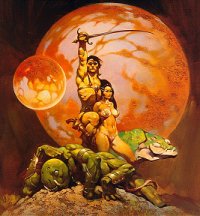 Whatever
the case, avid readers of the future will continue to devour the novels
of Burroughs, and as T. J. Glenn recently averred: "As long as literature
exists the words of Edgar Rice Burroughs and the epic deeds of his undying
hero will also live; immortal, unconquerable and exciting" (p. 28).
Whatever
the case, avid readers of the future will continue to devour the novels
of Burroughs, and as T. J. Glenn recently averred: "As long as literature
exists the words of Edgar Rice Burroughs and the epic deeds of his undying
hero will also live; immortal, unconquerable and exciting" (p. 28).
Certainly, the longevity of the Martian novels as popular
literature, regardless the manifold changes in society, commend them for
further serious study. Most assuredly, those reading of distant Barsoom
will be entertained; and, if they likewise learn some lessons on racial
toleration, that will be an added, and perhaps not altogether unintended
bonus.

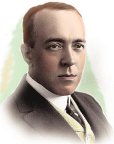
 Burroughs'
Mars — "Barsoom" — was a dying planet to which Captain John Carter, a Virginia
Confederate veteran, was mysteriously transported by a type of astral projection.3
On Mars, however, he became flesh. The planet resembled somewhat
that of Percival R. Lowell about a dying civilization, though the author's
scientific understanding was sketchy at best. (Mullen, 230; Markley,
186-187; Brady, 33-34; Clute, 177-179). While the stories may show a paucity
of scientific knowledge, they revealed much about ERB's predispositions
on race. It appeared that "Burroughs develop[ed] his heroes and their
arenas for adventure according to his conception how the world is and
how it ought to be [Italics added]” (Kudlay and Leiby, 68).4
Burroughs'
Mars — "Barsoom" — was a dying planet to which Captain John Carter, a Virginia
Confederate veteran, was mysteriously transported by a type of astral projection.3
On Mars, however, he became flesh. The planet resembled somewhat
that of Percival R. Lowell about a dying civilization, though the author's
scientific understanding was sketchy at best. (Mullen, 230; Markley,
186-187; Brady, 33-34; Clute, 177-179). While the stories may show a paucity
of scientific knowledge, they revealed much about ERB's predispositions
on race. It appeared that "Burroughs develop[ed] his heroes and their
arenas for adventure according to his conception how the world is and
how it ought to be [Italics added]” (Kudlay and Leiby, 68).4
 At
another point in the narrative, Carter and Princess Dejah Thoris escape
and are recaptured. Tal Hajus, the cruel Jeddak (leader) of the Tharks,
ordered the death of the Princess, adding: "But before the torture you
shall be mine for one short hour" (A Princess of Mars, 106).
This type of rape scenario is suggested many times throughout the novel,
most often with Dejah or some other beautiful red woman as the potential
victim.
At
another point in the narrative, Carter and Princess Dejah Thoris escape
and are recaptured. Tal Hajus, the cruel Jeddak (leader) of the Tharks,
ordered the death of the Princess, adding: "But before the torture you
shall be mine for one short hour" (A Princess of Mars, 106).
This type of rape scenario is suggested many times throughout the novel,
most often with Dejah or some other beautiful red woman as the potential
victim.
 Carter’s
black ally, Xodar, explained the origins of the white race of Mars: "The
Therns are but the result of ages of evolution from the pure white ape
of antiquity. They are a lower order still. There is but one
race of true and immortal humans on Barsoom. It is the race of black
men" (The Gods of Mars, 69). It cannot be mere happenstance
that Burroughs reversed one of the most popular of racist Darwinian arguments.
This argument is best exhibited in the words of R. W. Shufeldt, who, writing
in 1907, stated that the Negro "exhibits a much closer approach to the
anthropoid apes than any other race of the genus Homo." (p. 36).
Carter’s
black ally, Xodar, explained the origins of the white race of Mars: "The
Therns are but the result of ages of evolution from the pure white ape
of antiquity. They are a lower order still. There is but one
race of true and immortal humans on Barsoom. It is the race of black
men" (The Gods of Mars, 69). It cannot be mere happenstance
that Burroughs reversed one of the most popular of racist Darwinian arguments.
This argument is best exhibited in the words of R. W. Shufeldt, who, writing
in 1907, stated that the Negro "exhibits a much closer approach to the
anthropoid apes than any other race of the genus Homo." (p. 36).
 When
Carter had his first encounter with the blacks, they were attacking the
Therns and Carter was disguised as a Holy Thern in order to rescue his
beloved Dejah Thoris. Impressed by his military skills one black
cried out to him, "But for your detestable yellow hair and your white skin
you would be an honour to the First Born of Barsoom" (The Gods of Mars,
59).
When
Carter had his first encounter with the blacks, they were attacking the
Therns and Carter was disguised as a Holy Thern in order to rescue his
beloved Dejah Thoris. Impressed by his military skills one black
cried out to him, "But for your detestable yellow hair and your white skin
you would be an honour to the First Born of Barsoom" (The Gods of Mars,
59).
 The
success of Thomas Dixon proves the point. Dixon's novels sold millions
and were reviewed in the New York Times and other journals at a time when
Burroughs' books were seldom noted.
The
success of Thomas Dixon proves the point. Dixon's novels sold millions
and were reviewed in the New York Times and other journals at a time when
Burroughs' books were seldom noted.

